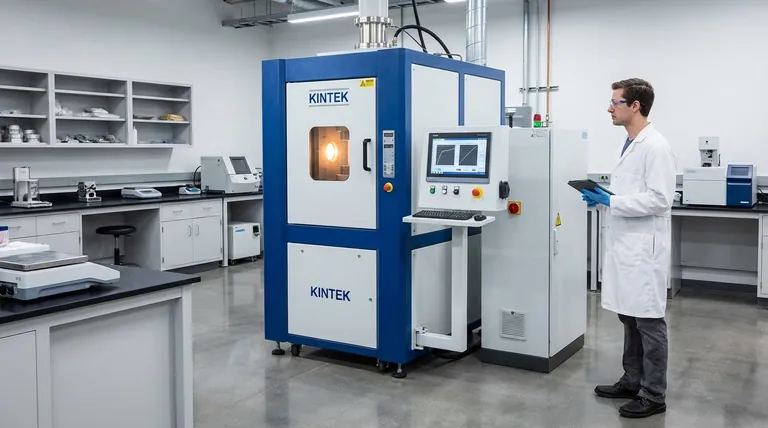Field Assisted Sintering Technique (FAST) is an advanced manufacturing process that uses a powerful electric current to simultaneously heat and compact a powder material into a solid, dense object. Unlike a conventional furnace which heats from the outside, FAST generates heat directly within the powder and its mold due to their electrical resistance, enabling extremely high heating rates and drastically shortening the production cycle.
The core advantage of FAST is its ability to generate heat internally. This direct heating method is fundamentally faster and more efficient than external heating, allowing for the creation of dense, high-performance materials with fine-grained microstructures that are difficult to achieve with traditional sintering.

How FAST Delivers Unmatched Speed and Efficiency
To understand why FAST is a transformative technology, it's essential to grasp its core working principle and how it differs from conventional methods like hot pressing.
The Core Mechanism: Joule Heating
The process works by passing a high-amperage, low-voltage direct current through the die and, in many cases, the powder itself. As the electricity encounters resistance, it generates intense heat—a phenomenon known as Joule heating. This is the same principle that makes a toaster filament glow.
Direct and Uniform Heat Generation
Conventional furnaces heat a part from the outside-in, a slow process that can lead to uneven temperatures. FAST generates heat throughout the material volume simultaneously. This results in very high and uniform heating rates, often exceeding 1000°C per minute.
Enhanced Sintering Activity
The combination of pressure, rapid heating, and the presence of the electric field itself significantly accelerates the diffusion process at the particle surfaces. This increased sintering activity allows the powder particles to bond together and densify at lower overall temperatures than required in conventional processes.
Key Advantages Over Conventional Sintering
The unique mechanism of FAST translates into several significant, practical benefits for material production.
Drastically Reduced Cycle Times
Where a conventional hot press cycle might take several hours, a FAST cycle can often be completed in 5 to 15 minutes. This massive reduction in processing time enables rapid prototyping and higher production throughput.
Lower Sintering Temperatures
By enhancing the sintering activity, FAST allows for full densification at lower peak temperatures. This is critical for preventing unwanted grain growth in the material, which preserves fine or even nanostructured microstructures.
Superior Material Properties
The ability to maintain a fine-grained structure typically results in materials with superior mechanical properties, such as increased hardness, strength, and fracture toughness.
Understanding the Trade-offs
While powerful, FAST is not a universal solution. Its application comes with specific considerations that must be weighed against its benefits.
Material and Geometry Constraints
The process is most straightforward for electrically conductive materials like metals and some ceramics. While non-conductive powders can be sintered using a conductive die (e.g., graphite), it adds a layer of complexity. Furthermore, the process is generally limited to producing relatively simple shapes.
Equipment Complexity and Cost
FAST systems require a specialized press integrated with a high-current power supply and a vacuum or controlled atmosphere chamber. This equipment is significantly more complex and carries a higher capital cost than a standard furnace.
Process Control Challenges
The extremely high heating rates demand highly responsive and precise control systems. Preventing temperature overshooting and ensuring uniformity, especially in larger parts, requires significant process expertise.
When to Consider FAST for Your Project
Choosing the right sintering method depends entirely on your end goal.
- If your primary focus is rapid material discovery: FAST is an unparalleled tool due to its extremely short cycle times, allowing you to test numerous compositions and processing parameters quickly.
- If your primary focus is producing high-performance, fine-grained materials: The ability to sinter at lower temperatures makes FAST the superior choice for preserving nanostructures and achieving enhanced mechanical properties.
- If your primary focus is reducing energy consumption and production time for suitable parts: The speed and efficiency of the process can offer significant operational cost advantages over slower, conventional methods.
Ultimately, FAST provides engineers and scientists with a powerful capability to create advanced materials with superior properties in a fraction of the time required by traditional methods.
Summary Table:
| Feature | FAST | Conventional Sintering |
|---|---|---|
| Heating Method | Internal (Joule heating) | External (furnace) |
| Typical Cycle Time | 5 - 15 minutes | Several hours |
| Sintering Temperature | Lower | Higher |
| Grain Growth | Minimal (fine microstructure) | More significant |
| Ideal For | Rapid prototyping, high-performance materials | Standard material production |
Ready to accelerate your material development with FAST technology?
KINTEK specializes in advanced lab equipment, including sintering solutions. Our expertise can help you leverage FAST to rapidly prototype new materials and achieve superior mechanical properties with fine-grained microstructures.
Contact our experts today to discuss how FAST can transform your R&D process and bring your high-performance material projects to life faster.
Visual Guide

Related Products
- Spark Plasma Sintering Furnace SPS Furnace
- CF KF Flange Vacuum Electrode Feedthrough Lead Sealing Assembly for Vacuum Systems
- Custom PTFE Teflon Parts Manufacturer for PTFE Mesh F4 Sieve
- Customizable PEM Electrolysis Cells for Diverse Research Applications
- Electrolytic Electrochemical Cell for Coating Evaluation
People Also Ask
- What is the mechanism of SPS? Unlock Rapid, Low-Temperature Densification
- What is the difference between spark plasma sintering and flash sintering? A Guide to Advanced Sintering Methods
- What is spark plasma sintering process? Fast-Track to Dense, Fine-Grained Materials
- What are the uses of spark plasma sintering? Fast, Low-Temp Fabrication of Advanced Materials
- What is the plasma sintering method? Unlock Rapid, High-Density Material Fabrication



















